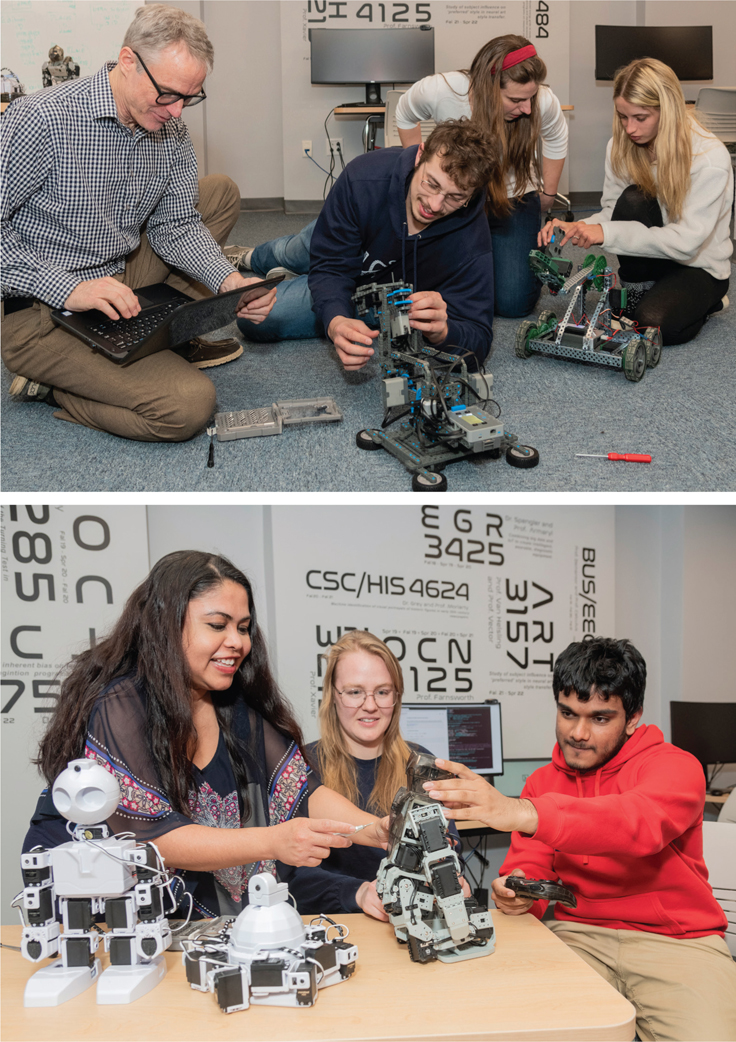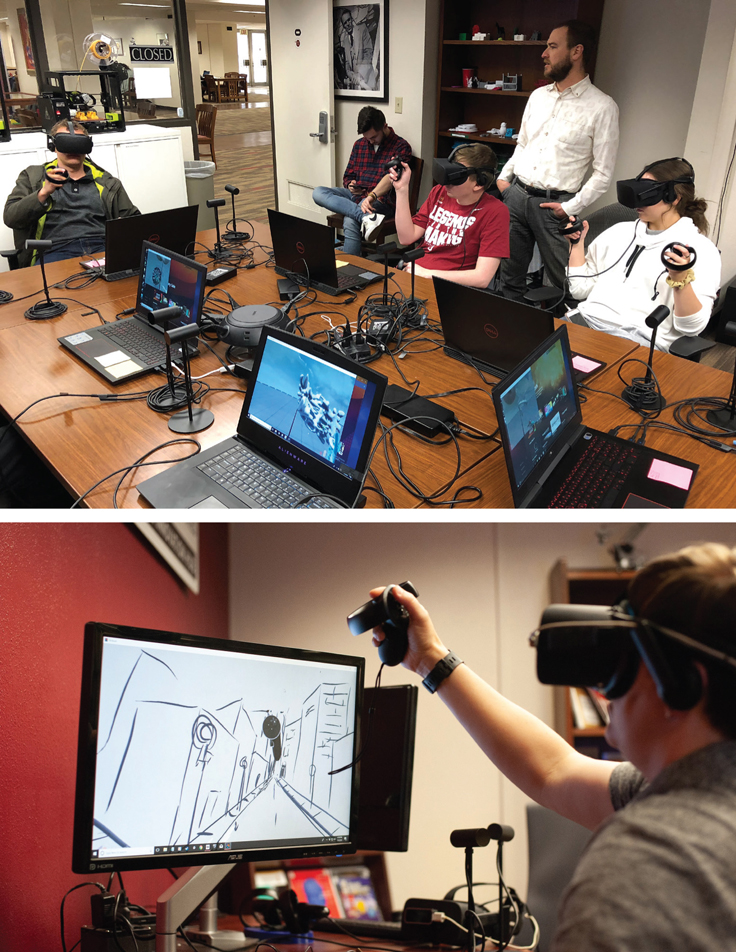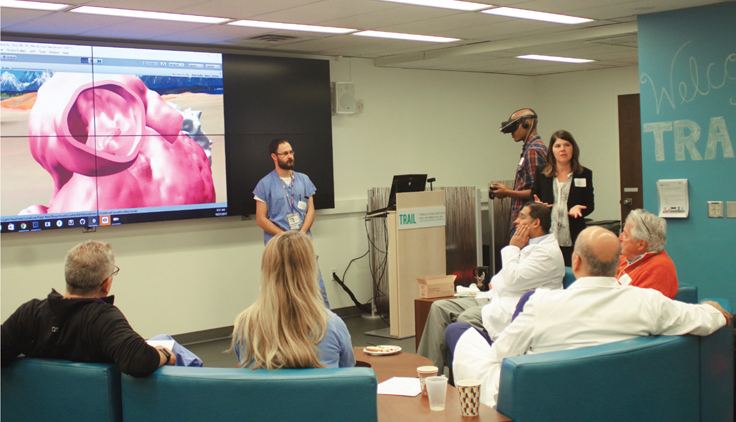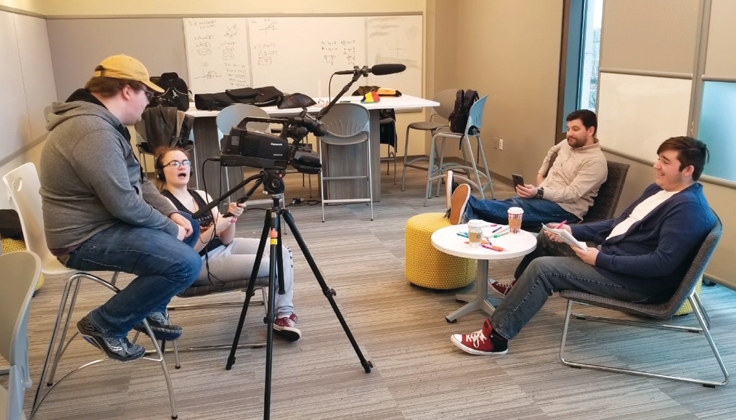Labs in the Library
When the University of Rhode Island (URI) opened its new artificial intelligence lab on the first floor of the Robert L. Carothers Library and Learning Commons last September 2018, URI president David M. Dooley said that “this lab will be more than just a technology center. It will be a place of ideas, discussion, and debate.”
When the University of Rhode Island (URI) opened its new artificial intelligence (AI) lab on the first floor of the Robert L. Carothers Library and Learning Commons last September 2018, URI president David M. Dooley said that “this lab will be more than just a technology center. It will be a place of ideas, discussion, and debate.”
AI is certainly a topic ripe for discussion. Voice-activated assistants are becoming ubiquitous. Self-driving cars are already on the roads. Concerns regarding bias in algorithms are being raised. Predictions that the technology will ultimately cause an unprecedented upheaval in labor and employment are beginning to lead to calls for universal basic income.
URI’s lab is believed to be the first such facility located in an institution’s main library. What better spot? While AI research is hardly new to university computer science departments, students and faculty in sociology departments or business schools, for example, may just now be learning about AI-based research applications. And libraries are well suited to host workshops “covering technical topics that are evolving so rapidly that they haven’t been incorporated into the curriculum yet,” notes Harrison Dekker, URI data services librarian and interim director of the lab.
These opportunities aren’t limited to AI. In addition to URI, LJ here profiles three other new library labs that are introducing technology to campus and acting as multidisciplinary hubs to explore new trends.

Top: Harrison Dekker, URI associate professor and director of the Artificial Intelligence (AI) Lab at the University of Rhode Island; Jaime Jaramillo, a sophomore chemical engineering major; Angelica Ferria, URI media curator; and Sydney Cirone, a junior textiles, fashion merchandising and design major, troubleshoot robots. Bottom: Indrani Mandal (l.), an AI Lab instructor, works on robots with Brinn Van Denburg, a senior applied mathematics major, and Avi Shrivastava, a junior accounting and political science double major.
Photos by Michael Salerno, URI
AI FOR ALL
For URI, the logic was simple. “One of the reasons for having this in the library is so it won’t be perceived as an adjunct resource for a particular department,” explains Dekker.
Funded by a $143,065 grant from the Champlin Foundation, URI’s AI lab is powered by an Nvidia DGX-1 GPU-based server. Described by MIT Technology Review as a “pint-sized supercomputer,” the DGX-1 was the first commercially built server designed specifically for AI research when it launched in 2016. In addition to a dedicated workstation, users of the lab have access to six Lambda Tensorbooks—$3,000-plus laptops specially outfitted for deep learning applications and preinstalled with AI development frameworks, TensorFlow, PyTorch, Caffe, Caffe 2, Keras, CUDA, and cuDNN—as well as a development kit for the Nvidia Jetson TX2 “supercomputer on a module.”
Several cloud-based AI and machine learning services are available from providers such as Microsoft Azure, Google Cloud, and Amazon Web Services for university libraries interested in providing access to AI research tools without the up-front investment in equipment. But “you do lose out on something,” Dekker says. “There’s a pretty big core of students who really do like the machinery.”
The lab has already led to well-attended workshops on topics such as “Robots with Legs,” a presentation by Boston Dynamics senior roboticist Yeuhi Abe, and the “People of Color-AI” meet-up on April 4 to “discuss ethical considerations underlying AI and machine learning projects and how diversity and inclusion are handled in the field.”
General interest in AI is leading to impromptu discussions between lab staff and students from a variety of fields, which has also helped staff brainstorm new workshops and highlight other relevant offerings.
“Having something new that’s getting recognition makes it easier to promote other new things,” Dekker says. “We’re using it as a platform for offering workshops that are more interdisciplinary—for instance on Python programming or R programming. It gives us credibility to branch out into other things.”

Top: A VR course in progress at Innovation @ The Edge, at the University of Oklahoma’s (OU) Bizzell Memorial Library. Bottom: OU emerging technologies librarian Kristi Wyatt demonstrates perspective drawing with a digital canvas using Google Tiltbrush.
Photos by Ashley West, University of Oklahoma Libraries
SURGICAL PRECISION
In the near future, virtual reality (VR) training will likely be de rigueur for medical students, and doctors at modern hospitals will have access to headsets, specialized viewing screens, and software enabling detailed, 3-D analysis of a patient’s tumor or aneurysm prior to surgery. This leading-edge technology is already in use at institutions such as Stanford Medicine, the Mayo Clinic, and Mount Sinai, and companies such as Surgical Theater, FundamentalVR, and Arch Virtual are beginning to create specialized software for VR training and presurgical consultations.
When the University of Washington’s Health Sciences Library (UWHSL) debuted its Translational Research and Information Lab (TRAIL) in November 2016, the new “incubator space” featured a six 55-inch panel data visualization wall, computers, whiteboards, and videoconferencing equipment for UWHS faculty, investigators, and affiliates. Library staff were prepared to provide individual consultations regarding data management and visualization tools such as Research Electronic Data Capture (REDCap) and Tableau, as well as host workshops.
Not long after launch, researchers from UW’s Center for Cardiovascular Innovation (CCVI) began asking if TRAIL could provide VR services as well.
“I like to think of [CCVI] as the tech people of the School of Medicine,” says Michael T. Moore, grants administration and special projects librarian for UWHSL. “They’re always on the cutting edge, finding new ways to improve health care. They were our first introduction to VR…and it was also nice that they immediately saw the value of the library,” for hosting, viewing it as an ideal meeting place for faculty and clinicians.
UWHSL received an Institute of Museum and Library Services (IMLS) leadership grant of $25,000, supplemented with funding from the Kenneth S. and Faye G. Allen Library Endowment, to study and build out the new space in collaboration with design architect Gili Meerovitch of Pfeiffer Partners Architects, CCVI, and other researchers from the UW Medical Center.
In addition to the library’s new VR studio, the study resulted in “Virtual Reality in Academic Health Sciences Libraries: A Primer” (available for free download at hsl.uw.edu/vr-studio). Published last year, the document presents a case study offering valuable insights not only to health sciences libraries interested in creating similar studios but also to any library wanting to develop a research- or training-focused VR space. It features analysis of current VR equipment, room size and buffer zones, what will be needed in terms of audience support, optimal lighting, flooring, network and other infrastructure, and patient privacy protection.
“As part of this process, I learned that if the health sciences library were to remain relevant to researchers in 2030, the planning and testing of space and design concepts needed to begin immediately,” Tania P. Bardyn, associate dean of UW Libraries and director of UWHSL, writes in the primer’s introduction.
Part of the original vision for the studio was to offer a space for presurgical consultations. Doctors typically rely on multiple 2-D MRI and CT representations of a patient’s heart, for example, prior to surgery. With VR, these 2-D scans can be used to design a virtual 3-D model, which a surgeon could analyze using a VR headset, while other members of a team watch using the data wall.
Currently available software does not offer a simple, turnkey-type solution for this application, however, notes Adam Garrett, systems manager for UWHSL. Teams have been able to build patient-specific models, but the process is difficult and time-consuming, requiring eight hours of work by skilled radiologists in one case. “What they want to be able to do is coming, but it’s not there yet,” Garrett says.
The new studio has proven useful for training applications using prerendered models both for CCVI and other UW medical school departments, and as groups such as CCVI provide feedback to software developers, UWHSL’s VR studio will be ready for these next-generation uses.

The new medical VR studio in the University of Washington Health Sciences Library may ultimately be used by groups of doctors during presurgical consultations.
Photo by Molly Duttry
VIRTUAL CLASSROOMS
Fortunate timing helped place the University of Oklahoma’s (OU) Bizzell Memorial Library in the vanguard of the current academic VR movement. The library’s “Innovation @ The Edge” lab was originally conceived as a Maker space for students in OU departments that didn’t have easy access to tools such as 3-D printers, microelectronics kits, and other equipment employed in prototyping and creation.
In fall 2015, a VR station designed for the library’s “Galileo’s World” special exhibit proved exceptionally popular. So when Innovation @ The Edge launched the following January, the lab’s leaders knew VR would become a key offering. Immersive headsets from Oculus Rift and HTC Vive became commercially available that spring, resulting in the “parallel development of 3-D and VR technology along the same time line as developing our Maker space,” says Matt Cook, head of emerging technologies for OU Libraries and a 2015 LJ Mover & Shaker. “We shifted focus to 3-D tools.”
These efforts included the development of OVAL (Oklahoma Virtual Academic Laboratory), a networked VR classroom application that enables up to 20 simultaneous users to inhabit the same VR space and import 3-D content. In March, OU released version 2.0 of the software for free on github (github.com/OUETL/OVAL).
Since its debut, Innovation @ The Edge has become a multidisciplinary center on campus, enabling students in fields as varied as biochemistry and archaeology to explore microscopic protein structures or distant ruins in collaborative virtual environments.
In a Wednesday interview in March, Cook described the past three days of activity in the lab, noting that Monday began with a free open workshop for interested faculty, staff, students, and the general public, offering attendees the opportunity to try VR for the first time, or receive hands-on instruction with 3-D scanning to incorporate objects into VR environments.
Tuesday, the lab hosted one of its longest-running partnerships, with students in the College of Architecture’s Capstone course visiting as part of a multiweek series of iterative design classes.
“They come over a period of six to eight weeks, twice per week, and they will update and critique their architectural designs in VR.... They’ll go in, annotate and take screenshots, and walk through in VR with their team to figure out: Where does the furniture need to be placed? What’s wrong with the ceiling? Why aren’t there stairs here? Is this too narrow of a hallway? Is this ADA [Americans with Disabilities Act] compliant?”
The architecture field has been an early adopter of VR for this purpose, Cook notes, so students are not only receiving feedback to improve their Capstone projects, they’re also receiving valuable hands-on experience with tools they will likely use when they graduate and enter the field.
On Wednesday, a biomechanics course and biochemistry course had already visited with back-to-back reservations.
“For our 2017–18 academic year, we had 609 students [use the lab] in for-credit course integrations across 12 colleges. That’s not counting thousands of walk-in VR sessions, workshop attendees, and on average 500 or so course assignments or modules per academic year.”

The Media and Gaming Lab at Lindenwood University, St. Charles, MO, includes collaborative work spaces for storyboarding, discussion, or, in this case, recording an interview.
Photo by Paul Huffman, Lindenwood University
NOT JUST FUN AND GAMES
The global video game industry generated almost $135 billion in revenue in 2018, an increase of 11 percent over 2017, according to Newzoo, a market analytics company focused on games and e-sports. Many universities now offer programs in video game design for students aiming for careers in this huge and growing sector of the entertainment industry, and a handful of institutions have begun embracing the role that campus libraries can play in a field in which disciplines including art, computer programming, and business intersect.
Until fairly recently, within academia, “there wasn’t a lot of understanding that it has become a cultural phenomenon—a huge business,” notes Michael Fetters, digital librarian for Lindenwood University (LU), St. Charles, MO.
When LU opened its Library and Academic Resources Center (LARC) in September 2017, it included the new Media and Gaming Lab (MGL), featuring all of the digital creation, editing, and production tools that students in LU’s game design, graphic design, cinema arts, or other programs would need.
“We want students to have a good experience and see the library as more than just an online [resource],” Fetters says. Centralizing resources provides students in these creative programs with “an actual, physical space where they can come to work on their own endeavors and use the skills they’re getting in their courses on their own projects.”
In addition to collaborative work spaces for storyboarding and a seating area with consoles for playing or testing games, MGL provides access to six Wacom Pen Tablets, as well as ten PCs and four Macs. These are loaded with software including AutoDesk 3ds Max, Maya, and Mudbox; Avid Media Composer; Final Cut Pro; Fusion 9; Blender; Cinema 4D; Adobe Premiere Pro, After Effects, Animate, Gaming SDK, and Audition; and much more.
Discussions with faculty helped the library determine what software would be needed for these workstations prior to MGL’s launch, and Fetters says the lab keeps tabs on changing trends to ensure that the selection stays up-to-date and relevant.
“We’ve had a lot of software we’ve had to add in the past year and a half,” Fetters says. “There’s so much change in the software that’s being used or no longer being used—particularly with some of the 3-D design and VR” software packages.
Productions crafted in the lab can be viewed in LARC’s theater, which MGL also supports. And any LU students, faculty, or staff can reserve the lab’s soundproofed audiovisual production rooms outfitted with professional recording equipment, attend workshops on topics such as podcasting and courses to become certified with Adobe Creative Suite software, or sign up for assistance with multimedia projects.
Still, all work and no play just isn’t right for a gaming lab. MGL also offers open role playing game (RPG) events and board game nights for students. Fetters hosts the library’s “Gamer’s Den” podcast and has begun curating a collection of formative video game titles for both research and fun.
“Designers want to look at not just what’s current but where these ideas [came] from,” Fetters says.
MAKING IT WORK
Now in operation for more than three years, Innovation @ The Edge is by far the longest-running lab of the four profiled here, and of these concepts, multidisciplinary VR resources are gaining the most widespread traction in university libraries. Cook credits the Bizzell Library’s success with the concept to its ongoing introductory workshops and its efforts to incorporate the lab as a regular component in for-credit courses across multiple departments.
For introductory workshops, focus on tangible outputs, Cook suggests, “rather than the more dry ‘here’s how the technology works 101.’ Our philosophy is ‘what can you do with these tools?’ You don’t have to be a computer scientist to use VR, you don’t have to be an engineer to use a 3-D printer. I think that’s really driven the first wave of traffic.”
Also, “consider the logistics of moving potentially large numbers of students through these spaces,” Cook says. Associating a classroom or meeting room nearby, as URI has done with its Galanti Lounge on the third floor of the Carothers Library for recent AI meet-ups, can be helpful for workshops or orientation lectures prior to course integrations. And while UWHSL’s medical VR addition to TRAIL is for groups of researchers, audience space was also a focal point while modeling the lab.
Staff is a key consideration as well, Dekker says. “It’s not enough for libraries to just open the doors.... If other libraries are interested in doing something like [an AI lab], they have to be committed to staffing it adequately.”
If part of a lab’s goal is to spark discussion or multidisciplinary collaboration using an emerging technology, keep in mind that the library will be inviting users with widely varied levels of expertise with that technology, he adds.
“It takes a unique set of skills to offer a service [for which] you can give technical support to users of all levels,” Dekker says. “It takes a certain type of patience, a high degree of technical experience, and the confidence to just wing it at times.”
In addition to Dekker, who has a background in coding, URI’s AI lab launched with support from professors in the university’s Department of Computer Science and Statistics and Department of Electrical, Computer, and Biomedical Engineering.
To continue building these programs, it helps to have peer-reviewed expertise on tap. In addition to their primer on medical VR in libraries, Moore, Bardyn, and Sandeep Napa, a student in UW’s Biomedical Informatics and Medical Education department, recently published in the Journal of Medical Internet Research a usability study of commercially available VR apps for presurgical case planning, contributing to the academic critique of current VR medical software.
Cook, meanwhile, has coauthored multiple papers on VR and learning outcomes, as well as an upcoming book, Virtual Reality in the Academic Library: A Practical Guide. And OU last year hosted a national forum on 3-D and VR technologies in libraries as part of a three-part series funded by a $95,000 IMLS grant.
By providing collaborative spaces and inviting students and faculty to explore new technologies, academic libraries are essentially serving the same core mission they always have, Dekker says.
“The same way we make decisions about collections and try to anticipate what people’s information needs are, we can also monitor trends in curricular needs,” he says. “Rather than, say, purchasing materials that might potentially be needed, we can be planning and offering workshops, and providing access to technology.”
RELATED
ALREADY A SUBSCRIBER? LOG IN
We are currently offering this content for free. Sign up now to activate your personal profile, where you can save articles for future viewing









Add Comment :-
Comment Policy:
Comment should not be empty !!!